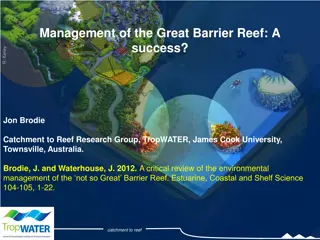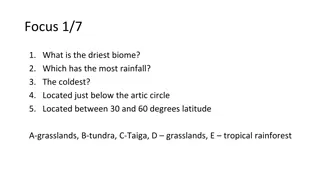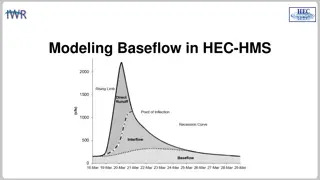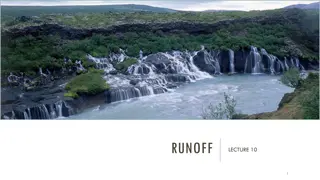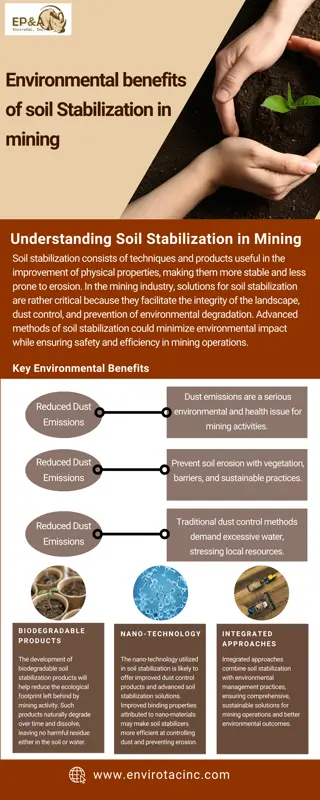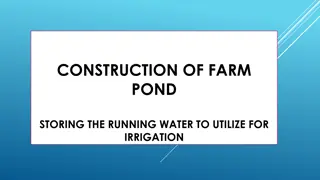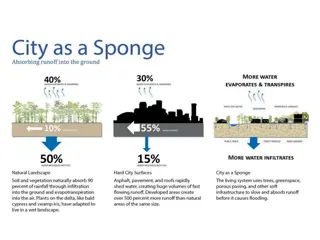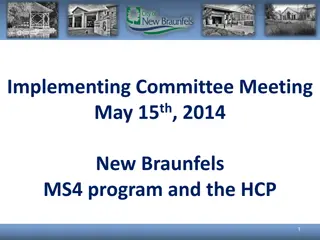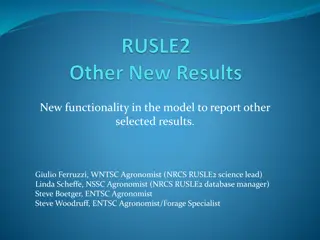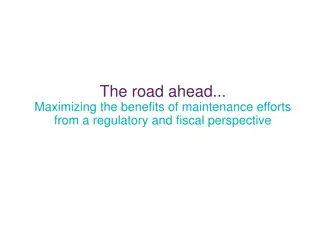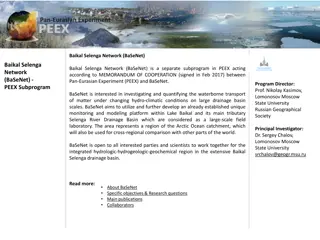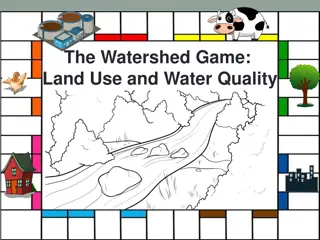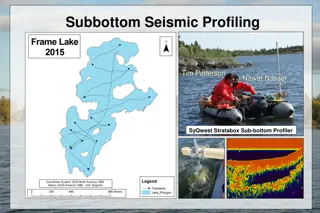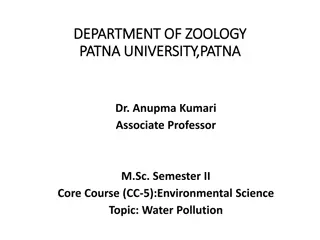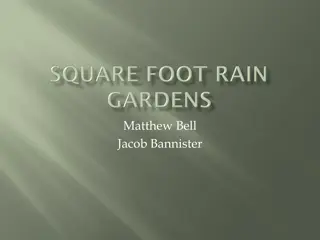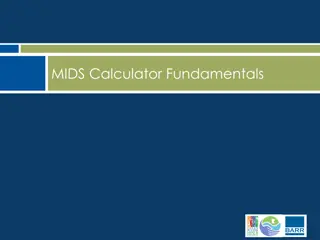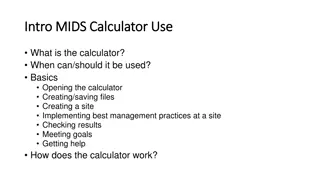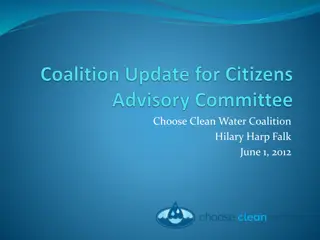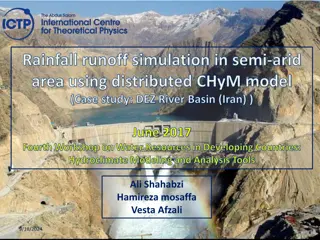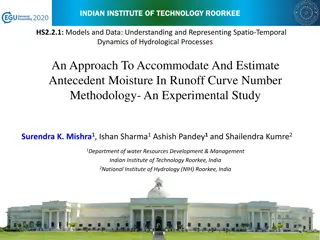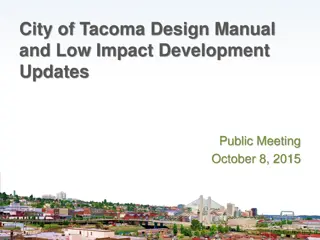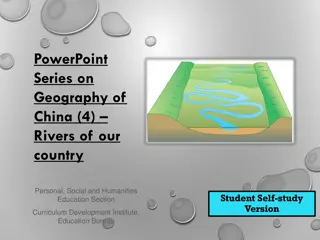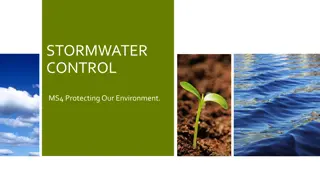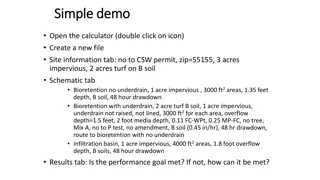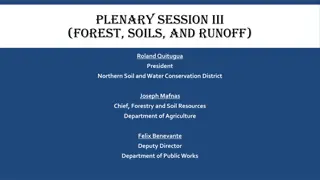Rainfall-Runoff Modelling Using Artificial Neural Network: A Case Study of Purna Sub-catchment, India
Rainfall-runoff modeling is crucial in understanding the relationship between rainfall and runoff. This study focuses on developing a rainfall-runoff model for the Upper Tapi basin in India using Artificial Neural Networks (ANNs). ANNs mimic the human brain's capabilities and have been widely used i
0 views • 26 slides
Understanding the Fate of Herbicides in Soil
The fate of herbicides in soil is influenced by factors such as micro-organism decomposition, chemical decomposition, photodecomposition, adsorption by soil, surface runoff, leaching, plant uptake, and volatilization. Micro-organisms like algae, fungi, actinomyces, and bacteria play a crucial role i
6 views • 7 slides
Understanding Total Solids and Total Suspended Solids in Water
Learn about total solids and total suspended solids in water, including their definitions, implications on water quality and aquatic life, and factors affecting their levels. Total solids refer to matter suspended or dissolved in water, while total suspended solids are small solid particles that can
7 views • 12 slides
Runoff
Runoff is the surface flow of precipitation in drainage channels that can be utilized for engineering purposes. Catchment characteristics, including stream order, drainage density, length of stream, form factor, and circularity ratio, play a crucial role in determining how well a watershed is draine
3 views • 30 slides
Understanding Runoff in Hydrology
Runoff in hydrology refers to surface water flow from precipitation and other sources in drainage basins. It plays a crucial role in stream flow and peak flood formation, influenced by factors like overland flow, interflow, and groundwater flow. This article explores the sources of runoff, including
1 views • 27 slides
Environmental Challenges Facing the Great Barrier Reef
The management of the Great Barrier Reef has faced significant challenges leading to a decline in coral cover, dugong populations, seagrass health, and shark populations. Issues such as fishing practices, terrestrial pollutant runoff, and climate change have contributed to the deterioration of the r
0 views • 16 slides
Exploring Tropical Rainforests: A Diverse and Vital Ecosystem
Tropical rainforests, found near the equator, boast immense biodiversity and play crucial roles in regulating global climate and nutrient cycles. These forests thrive in humid, warm conditions with ample sunlight. Nutrients are primarily found in plants rather than the soil, and their efficient nutr
0 views • 27 slides
Understanding Human Impact on Water Systems in Agriculture
Human activities, such as animal farming, can significantly impact the Earth's surface and water systems by introducing excess nutrients and waste runoff. This leads to eutrophication, soil erosion, and water contamination. Farmers are working on conservation practices to mitigate these issues, such
2 views • 10 slides
Understanding Baseflow Modeling in HEC-HMS
Baseflow in HEC-HMS plays a crucial role in modeling runoff volume, consisting of groundwater flow components like interflow and baseflow. Different approaches are used to model baseflow, with HEC-HMS currently incorporating conceptual methods. The response times for interflow and baseflow differ, i
1 views • 7 slides
Understanding Runoff in Surface Water Systems
Runoff, the flow of precipitation and other contributions in surface streams, plays a crucial role in watershed systems. It encompasses various sources such as surface runoff, interflow, and base flow. Surface runoff, which travels over the ground surface to channels, is influenced by factors like s
1 views • 27 slides
Environmental benefits of soil stabilization in mining
Soil stabilization in mining reduces dust emissions, prevents erosion, conserves water, enhances vegetation growth, and minimizes chemical runoff for environmental sustainability.\n
0 views • 1 slides
Environmental benefits of soil stabilization in mining
Soil stabilization in mining reduces dust emissions, prevents erosion, conserves water, enhances vegetation growth, and minimizes chemical runoff for environmental sustainability.\n\n
2 views • 15 slides
Constructing Farm Ponds for Water Harvesting and Irrigation in Rural Areas
Proper water harvesting is essential for agricultural sustainability in rural areas. Farm ponds serve as reservoirs to store runoff and running water from natural sources, aiding in irrigation and fish production. The construction of a farm pond in Gram Panchayat Dulmot has significantly benefitted
0 views • 5 slides
Maintaining Catch Basins for Effective Drainage in New Orleans
Catch basins are crucial for managing surface runoff in New Orleans, but they need regular cleaning to prevent clogging and debris buildup. This guide explains the importance of cleaning catch basins, provides step-by-step instructions on how to clean and mark them properly, and introduces an app al
0 views • 7 slides
Understanding Hyetograph, Runoff, and Hydrograph in Hydrology
A hyetograph represents rainfall intensity over time, crucial for predicting extreme floods. Runoff is the unevaporated portion of rainfall that flows into rivers or oceans, while hydrograph displays discharge variations over time in streams. Surface runoff, interflow, and base flow are key classifi
0 views • 15 slides
Storm Water Management Program Overview - May 15th, 2014 Committee Meeting
This program overview from the Committee Meeting on May 15th, 2014 in New Braunfels covers the MS4 program, HCP, storm water permit updates, TPDES regulations, SWMP, permit requirements, and program implementation details including public education, illicit discharge detection, construction site run
1 views • 19 slides
Enhancing Model Functionality for Reporting Selected Results
The new functionality in the model allows for reporting various selected results related to soil loss, runoff, forage demand, and consumption. Different color codes are used to represent different values, making it easy to identify soil condition and erosion status. Additionally, new parameters for
0 views • 7 slides
Understanding Pollution Impact on Watersheds
The content covers the impact of human activities on watersheds, focusing on pollutants like oil, nutrients, and bacteria. It emphasizes the importance of protecting watersheds and offers solutions to prevent pollution. Examples include oil runoff affecting drinking water sources and nutrient pollut
0 views • 7 slides
Maximizing Maintenance Benefits for Environmental Compliance
Explore the significance of maintenance efforts in maximizing benefits from both regulatory and fiscal perspectives. Learn how routine maintenance activities such as pond cleaning, street sweeping, and litter control can lead to cost savings and regulatory compliance. Discover how keeping track of c
0 views • 18 slides
Managing Urban Stormwater Runoff: North Hennepin Community College MS4 Plan
North Hennepin Community College is designated as an MS4 due to its location in an urban area, aiming to treat urban stormwater runoff and improve water quality. The MS4 Plan includes implementing six minimum control measures, such as public education, illicit discharge detection, and construction s
0 views • 10 slides
Baikal Selenga Network (BaSeNet) - Hydrologic Research Program in PEEX
Baikal Selenga Network (BaSeNet) is a subprogram under PEEX focusing on studying waterborne matter transport in the Lake Baikal and Selenga River Drainage Basin. The program aims to quantify hydro-climatic impacts on large scales, utilizing a monitoring and modeling platform. Research objectives inc
0 views • 5 slides
Understanding Watersheds and Land Use Impact on Water Quality
Explore the concept of watersheds, their boundaries, water runoff, and infiltration, and how different land use types within watersheds can influence nutrient input. Discover the impact of water flow on ecosystems and marine life, emphasizing the importance of responsible land use for maintaining wa
0 views • 13 slides
Environmental Impact Assessment of Frame Lake and Recommendations
The subbottom seismic profiling and stratigraphy studies reveal the sediment layers in Frame Lake and the impact of urban development on water quality. Glew coring analysis identifies layers of arsenic contamination. Recommendations include dredging to restore the lake's natural state pre-1975. The
0 views • 13 slides
Understanding Water Pollution and Its Impact on the Environment
Water pollution is a significant environmental issue caused by the contamination of water bodies with toxic substances like chemicals and microorganisms. This degradation in water quality poses risks to both humans and ecosystems. The pollutants stem from various sources such as agricultural runoff,
0 views • 59 slides
Implementing Rain Gardens for Sustainable Stormwater Management
Rain gardens offer an affordable and effective solution for homeowners to reduce stormwater runoff on their property. They provide numerous benefits such as filtering pollution, conserving water, and enhancing wildlife habitats. While installation may require some initial costs, maintenance is minim
0 views • 21 slides
Managing Stormwater in Infrastructure & Transport Planning: A Comprehensive Overview
Stormwater management is crucial for urban areas like Delhi due to heavy rainfall patterns and the risk of flooding. Factors influencing rainfall, runoff estimation methods, and water stagnation points are discussed. The importance of natural drainage systems in mitigating flooding is emphasized.
0 views • 5 slides
Understanding MIDS Calculator Fundamentals and Performance Goals
The MIDS Calculator is a tool used to evaluate site conformance to MIDS performance goals, focusing on volume reduction and annual pollutant removal. It provides flexible treatment options tailored to site characteristics and goals. Learn about various simplifications of treatment options, jargon re
0 views • 59 slides
Understanding the MIDS Calculator for Stormwater Management
The MIDS Calculator is an Excel-based tool that helps quantify stormwater runoff volume reduction and pollutant removal for Best Management Practices (BMPs). It can assist in selecting and sizing BMPs to meet regulatory or water quality objectives. Despite some limitations, it is widely used and off
0 views • 14 slides
Coalition for Clean Water: Advocating for Chesapeake Bay Restoration
The Choose Clean Water Coalition, led by Hilary Harp Falk, is a diverse group of over 230 organizations working towards restoring rivers and streams in the Chesapeake region. Their mission includes coordinating policies and actions at all levels to ensure clean-up success. With a vision of vibrant,
0 views • 25 slides
Rainfall-Runoff Simulation in Semi-Arid Area Using Distributed CHyM Model: DEZ River Basin Study
This case study delves into the simulation of rainfall-runoff using the CHyM model in the semi-arid area of the DEZ River Basin in Iran. The study focuses on water resources management, flood control, and forecasting of flood discharge parameters, emphasizing the importance of accurate modeling for
0 views • 22 slides
Understanding Spatio-Temporal Dynamics of Hydrological Processes at IIT Roorkee
This study conducted at the Indian Institute of Technology Roorkee focuses on modeling and understanding hydrological processes, particularly in estimating antecedent moisture in the Runoff Curve Number methodology. The research delves into the historical background of the Soil Conservation Service
0 views • 13 slides
Understanding Infiltration and Unsaturated Flow in Hydrology
This content delves into the key concepts of infiltration and unsaturated flow in hydrology, focusing on calculating infiltration, cumulative infiltration, and time to ponding using the Green-Ampt method. It covers important topics such as runoff rate, infiltration capacity, cumulative infiltration,
0 views • 8 slides
City of Tacoma Design Manual and Low Impact Development Updates
The City of Tacoma held a public meeting in October 2015 to discuss updates to the Design Manual and Low Impact Development. The updates aimed to address current city policies, comply with state regulations, and promote Low Impact Development as the preferred approach to site development. Various re
0 views • 60 slides
Calibration of Multi-Variable Rainfall-Runoff Model Using Snow Data in Alpine Catchments
Explore the calibration of a conceptual rainfall-runoff model in Alpine catchments, focusing on the importance of incorporating snow data. The study assesses the benefits of using multi-objective approaches and additional datasets for model performance. Various aspects such as snow cover, groundwate
0 views • 16 slides
Distribution Pattern of River Zones in China
China has a vast network of rivers with different characteristics and distribution patterns. The country is divided into five zones based on factors like precipitation and runoff levels, ranging from abundant to deficit zones. These zones play a crucial role in understanding the water resources and
0 views • 14 slides
Understanding Stormwater Management and Best Management Practices
Stormwater management is crucial for protecting our environment from pollutants in runoff water. Best Management Practices (BMPs) are a combination of structural, vegetative, and managerial techniques used to prevent water pollution and improve water quality. Learn about stormwater pollution, minimu
0 views • 15 slides
Stormwater Management Calculator Overview
Explore the functionalities of a stormwater management calculator that helps in analyzing stormwater runoff, pollutants, and BMP efficiencies. Learn about different BMP types, performance goals, and annual pollutant reduction targets to achieve effective stormwater management. Understand how the cal
0 views • 14 slides
Water Harvesting Techniques in Rainfed Agriculture & Watershed Management
Water harvesting plays a crucial role in rainfed agriculture by collecting and storing runoff water for irrigation in arid and semi-arid regions. Mr. Anil Swami, an assistant professor, discusses the importance of water harvesting techniques, including runoff farming and rainwater harvesting. He emp
0 views • 13 slides
Plenary Session III on Forest, Soils, and Runoff Featuring Key Speakers
The Plenary Session III on Forest, Soils, and Runoff showcased insights from prominent figures such as Roland Quitugua, President of the Northern Soil and Water Conservation District, Joseph Mafnas, Chief of Forestry and Soil Resources at the Department of Agriculture, and Felix Benevante, Deputy Di
0 views • 4 slides
Exploring Watersheds and Runoff with Physical and Computational Models
Engage in hands-on activities using physical models like a big tarp to simulate rainfall on landscapes and explore the movement of water. Dive into discussions about the pros and cons of using physical models for studying water flow. Discover the introduction to computational models and discretizati
0 views • 38 slides





